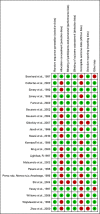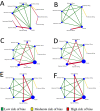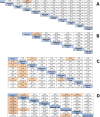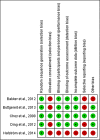Use of corticoids and non-steroidal anti-inflammatories in the treatment of rheumatoid arthritis: Systematic review and network meta-analysis
- PMID: 33826610
- PMCID: PMC8026036
- DOI: 10.1371/journal.pone.0248866
Use of corticoids and non-steroidal anti-inflammatories in the treatment of rheumatoid arthritis: Systematic review and network meta-analysis
Abstract
Evidence on the use of non-steroidal anti-inflammatory drugs (NSAIDs) and corticoids for rheumatoid arthritis (RA) is inconclusive and is not up to date. This systematic review assessed the effectiveness and safety of these anti-inflammatories (AI) in the treatment of RA. COCHRANE (CENTRAL), MEDLINE, EMBASE, CINAHL, Web of Science and Virtual Health Library were searched to identify randomized controlled trials (RCT) with adults which used AI (dose represented in mg/day) compared with placebo or active controls and was carried out up to December of 2019. Reviewers, in pairs and independently, selected studies, performed the data extraction and assessed the risk of bias. The quality of the evidence was assessed by GRADE. Network meta-analyses were performed using the Stata v.14.2. Twenty-six articles were selected (NSAIDs = 21 and corticoids = 5). Naproxen 1,000 improved physical function, reduced pain and the number of painful joints compared to placebo. Etoricoxib 90 reduced the number of painful joints compared to placebo. Naproxen 750 reduced the number of swollen joints, except for etoricoxib 90. Naproxen 1,000, etoricoxib 90 and diclofenac 150 were better than placebo regarding patient assessment. Assessment physician showed that NSAIDs were better than placebo. Meta-analyses were not performed for prednisolone and prednisone. Naproxen 1,000 was the most effective drug and celecoxib 200 showed fewer adverse events. However, the low quality of the evidence observed for the outcomes with NSAIDs, the absence of meta-analyses to assess the outcomes with corticoids, as well as the risk of bias observed, indicate that future RCT can confirm such findings.
Conflict of interest statement
The authors have declared that no competing interests exist.
Figures







Similar articles
-
Non-steroidal anti-inflammatory drugs (NSAIDs) for chronic non-cancer pain in children and adolescents.Cochrane Database Syst Rev. 2017 Aug 2;8(8):CD012537. doi: 10.1002/14651858.CD012537.pub2. Cochrane Database Syst Rev. 2017. PMID: 28770976 Free PMC article.
-
Cyclooxygenase-2 selective non-steroidal anti-inflammatory drugs (etodolac, meloxicam, celecoxib, rofecoxib, etoricoxib, valdecoxib and lumiracoxib) for osteoarthritis and rheumatoid arthritis: a systematic review and economic evaluation.Health Technol Assess. 2008 Apr;12(11):1-278, iii. doi: 10.3310/hta12110. Health Technol Assess. 2008. PMID: 18405470
-
Celecoxib for rheumatoid arthritis.Cochrane Database Syst Rev. 2017 Jun 9;6(6):CD012095. doi: 10.1002/14651858.CD012095.pub2. Cochrane Database Syst Rev. 2017. PMID: 28597983 Free PMC article.
-
Safety of non-steroidal anti-inflammatory drugs, including aspirin and paracetamol (acetaminophen) in people receiving methotrexate for inflammatory arthritis (rheumatoid arthritis, ankylosing spondylitis, psoriatic arthritis, other spondyloarthritis).Cochrane Database Syst Rev. 2011 Nov 9;(11):CD008872. doi: 10.1002/14651858.CD008872.pub2. Cochrane Database Syst Rev. 2011. PMID: 22071858
-
Systemic pharmacological treatments for chronic plaque psoriasis: a network meta-analysis.Cochrane Database Syst Rev. 2021 Apr 19;4(4):CD011535. doi: 10.1002/14651858.CD011535.pub4. Cochrane Database Syst Rev. 2021. Update in: Cochrane Database Syst Rev. 2022 May 23;5:CD011535. doi: 10.1002/14651858.CD011535.pub5. PMID: 33871055 Free PMC article. Updated.
Cited by
-
Melittin as a therapeutic agent for rheumatoid arthritis: mechanistic insights, advanced delivery systems, and future perspectives.Front Immunol. 2024 Dec 20;15:1510693. doi: 10.3389/fimmu.2024.1510693. eCollection 2024. Front Immunol. 2024. PMID: 39759520 Free PMC article. Review.
-
Pharmacological modes of plant-derived compounds for targeting inflammation in rheumatoid arthritis: A comprehensive review on immunomodulatory perspective.Inflammopharmacology. 2025 Apr;33(4):1537-1581. doi: 10.1007/s10787-025-01664-7. Epub 2025 Mar 13. Inflammopharmacology. 2025. PMID: 40074996 Review.
-
Ferroptosis: New Strategies for Clinical Treatment of Rheumatoid Arthritis.J Inflamm Res. 2025 May 21;18:6529-6541. doi: 10.2147/JIR.S523410. eCollection 2025. J Inflamm Res. 2025. PMID: 40416706 Free PMC article. Review.
-
Cost-effectiveness of janus kinase inhibitors for rheumatoid arthritis: A systematic review and meta-analysis of cost-utility studies.Front Pharmacol. 2022 Dec 13;13:1090361. doi: 10.3389/fphar.2022.1090361. eCollection 2022. Front Pharmacol. 2022. PMID: 36582538 Free PMC article.
-
The Journey of Methotrexate and Potential Alternative Pharmacotherapies for Rheumatoid Arthritis.Curr Drug Res Rev. 2025;17(2):142-152. doi: 10.2174/0125899775258634231226052204. Curr Drug Res Rev. 2025. PMID: 38284720 Review.
References
-
- Singh JA, Saag KG, Bridges SL Jr., Akl EA, Bannuru RR, et al.. (2016) 2015 American College of Rheumatology Guideline for the Treatment of Rheumatoid Arthritis. Arthritis Rheumatol 68: 1–26. - PubMed
Publication types
MeSH terms
Substances
LinkOut - more resources
Full Text Sources
Other Literature Sources
Medical

